International Journal of Computer Network and Information Security @ijcnis
Статьи журнала - International Journal of Computer Network and Information Security
Все статьи: 1166

Статья научная
In this paper we investigate traffic-engineering issues in Wavelength Division Multiplexing (WDM) all-optical networks. In such networks, the wavelength continuity constraint along with the wavelength clash constraint, lead to poor network performances when dealing with the lightpath provisioning problem. The impact of these constraints is especially severe when traffic demands are unpredictable and characterized by random arrivals and departures. In order to alleviate the impact of these constraints, we propose to employ intentional/active rerouting. Active lightpath rerouting is to intentionally reroute already established lightpaths, during their life period, so as to achieve a better blocking performance. We here assume that due to the large geographic area an optical WDM network can cover, upgrading such a network to support the huge demand for network bandwidth can be costly. Thereby, it is extremely important for network operators to apply traffic-engineering strategies to cost-effectively optimize network throughput. Two new routing and wavelength assignment (RWA) algorithms applying intentional rerouting are proposed. Both algorithms dynamically reroute some already established lightpaths from longer paths to vacant shorter ones so as to reduce the network resources consumption and hence improve the network throughput. The first algorithm, namely, Timer-Based Active Lightpath Rerouting (TB-ALR) initiates the rerouting procedure every time a timer expires. The second algorithm, namely, Sequential Routing with Active Lightpath Rerouting (SeqRwALR) initiates the rerouting procedure when a connection leaves and its lightpaths are released. To the best of our knowledge, our global approach has not already been investigated in the literature. Simulation results show that the proposed active rerouting algorithms yield much lower connection rejection ratios than rerouting algorithms previously presented in the literature while rerouting a small number of already established lightpaths. By rerouting a small number of existing lightpaths, we hope that the disruption period incurred due to rerouting is minimized.
Бесплатно
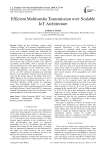
Efficient multimedia transmission over scalable IoT architecture
Статья научная
Today the new technology concept, called “Internet of Things” (IoT), presents a significant field of research, due to the fact that it promises many advantages to the users worldwide. Besides this, multimedia file streaming tends to be a daily user habit, as a result of the evolution of the internet and the capabilities of devices, such as mobile phones and computers. This tendency has established Cloud Computing (CC) as a vital technology due to the fact that it reduces economic costs, improves accessibility and flexibility, while it increases the total network performance too. This paper demonstrates a new technological approach for IoT architecture, where a layered implementation with the use of many cloud servers can offer optimized streaming and download, because of the significant reduction of the transfer time costs and the storage space of the Main Cloud Server (MCS). Moreover, users will have the ability to choose or adapt to their devices’ restrictions, between low - up to - Ultra-High Definition (UHD) quality for multimedia access and downloading, thanks to a new quality scalability feature which is introduced and is based on the new High-Efficiency Video Coding (HEVC) compression standard. Experimental results show the efficiency of the proposed approach with math formulas and graphs.
Бесплатно
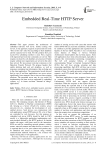
Embedded Real-Time HTTP Server
Статья научная
This paper presents the architecture of embedded real-time web server. Unlike existing web servers, in our approach, requests are processed not in the "first in first out" order but according to their deadlines and the expected server load. For this purpose the Least Laxity First scheduling method is used. First, requests with imposed hard real-time constraints are served. Then requests enclosed by soft deadlines are processed. Finally, request without time requirements are served in the order they arrived. We also present real-time extensions to the Hypertext Transfer Protocol. We propose headers that enable defining hard and soft deadlines, as well as responses containing time information, that are being sent to the client application. The experimental results showed that in case of real-time applications our server misses significantly fewer requests, due to time out, then existing solutions. The presented server may be very useful for implementing real-time services supported by embedded systems, e.g. in future real-time "Internet of things" applications.
Бесплатно
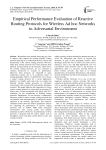
Статья научная
Researchers have already shown the way, how to improve and compare the existing MANET routing protocols that help us to understand the basic feature and functionality of the various routing protocols. However, while these routing protocols have been proposed from different research groups in the literature, which shows the existing routing protocols, are not consistent to common framework to evaluate its performance. Moreover, these protocols are vulnerable to many collaborative attacks, due to its cooperative nature of routing algorithms. Hence, it is difficult for one to choose a proper routing protocol for a given application; therefore, we initially study and review to compare the different existing routing protocols in adversarial environment with varying traffic and mobility simulation scenarios. This paper addresses the comparison of various reactive routing protocols in adversarial environment. To achieve this, we had investigated with widely used NS-2 simulators for fair comparisons of different routing protocols. Furthermore, we also develop a collaborative adversary model for these existing routing protocols that can interfere with communications to subvert the normal operation of the network. Specifically, Our extensive simulation results shows the relative quantitative analysis for comparing the performance of reactive routing protocols such as AODV, DSR under adversarial environments with varying traffic and mobility simulation scenarios. Moreover, the performance of these protocols is measured with the various metrics such as throughput, end-to-end delay, packet delivery ratio, and routing overhead.
Бесплатно
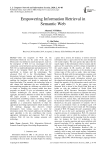
Empowering Information Retrieval in Semantic Web
Статья научная
Until the inception of Web 1.0, the Information Retrieval was the center of the stage for library and it was defined as search and passive. Later on, the emergence of Web 2.0 was encouraged into the community, social interaction and user-generated content. Web 3.0 is a modern phenomenon and also known to “3D Web or the Semantic Web”, and it often used for specifically to formats and the technologies. The advanced Web 4.0 is the Ultra-Intelligent Agent Interactions between humans and machines. Semantic web technology finds meanings from various sources to enabling the machines and people to understand and share knowledge. The semantic web technology helps to add, change and implement the new relationships or interconnecting programs in a different way which can be as simple as changing the external model that these programs are shared. To give an information need, the semantic technologies can directly search, capture, aggregate, and make a deduction to satisfy the user needs. The paper presents a framework for knowledge representation assembling semantic technology based on ontology, semantic web, and an intelligent agent algorithm as a connectivity framework to share the appropriate knowledge representation which includes the web ontology language that discovers related information's from various sources to serve the information needs. The research addresses the intelligent agent algorithm is the key contribution that reveals appropriate information and empowers Web 3.0 and embraces Web 4.0 into the coming semantic web technology.
Бесплатно
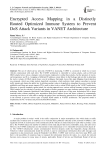
Статья научная
The use of vehicle ad hoc networks (VANET) is increasing, VANET is a network in which two or more vehicles communicate with each other. The VANET architecture is vulnerable to various attacks, such as DoS and DDoS attacks hence various strategies were previously employed to combat these attacks, but the presence of end-to-end transparency and N-to-1 mapping of different IP addresses create failure in the blockage and not able to determine the twelve variants of DDoS attacks hence a novel technique, Encrypted Access Hex-tuple Mapping Attack detection was proposed, which uses triple random hyperbolic encryption, which performs triple random encoding to encrypt traffic signals and obtains the public key by plotting random values in hyperbola to strengthen the access control in the middlebox and Deep auto sparse impasse NN is used to detect twelve variant DDoS attacks in the VANET architecture. Moreover, to provide immunity against attack, the existing approach uses various artificial immune systems to prevent DDoS attacks but the selection of positive and negative clusters generates too many indicator packets. Hence a novel technique, Stable Automatic Optimized Cache Routing proposed, which uses a Deep trust factorization NN to detect irrational nodes without requiring prior negotiation about local outliner factor and direct evidence by automatically extracting trust factors of each node to manage the packet flows and detecting transmission of dangerous malware files in the network to prevent various types of hybrid DDoS attacks at VANET architecture. The proposed model is implemented in NS-3 to detect and prevent hybrid DDoS attacks.
Бесплатно
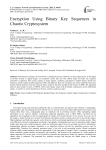
Encryption Using Binary Key Sequences in Chaotic Cryptosystem
Статья научная
Transmission of images on the network is considered insecure which has security-related issues. In this paper, to provide security to digital images, an encryption system that uses four chaotic maps for binary key sequence generation is proposed. The system consists of stages namely, confusion, generation of random binary chaotic key sequence, pseudo-random number generation (RN), and diffusion. Keys for encryption are chosen randomly based on a pseudo random generator from the selected chaotic maps by the linear feedback shift register (LFSR). The algorithm achieves good results in terms of NPCR, UACI, and entropy values. The developed cryptosystem resists differential attacks, is sensitive to minor alterations in the keys, and has a large key space.
Бесплатно
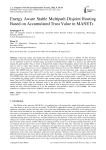
Energy Aware Stable Multipath Disjoint Routing Based on Accumulated Trust Value in MANETs
Статья научная
Conserving energy and finding the stable path are the two vital issues in Mobile Ad Hoc Networks (MANETs) as the prior increases the network lifetime and the later increases the network throughput. The nodes which are not legitimate in terms of residual energy and packet forwarding history might be a threat to the path thereby making the path unstable. Thus, it results in frequent link failure, reduced throughput, reduced network and path life time. In order to reduce these hazards, authors have proposed an energy efficient, reliable path selecting protocol referred to as Trust Based Energy Aware Multipath Disjoint Routing Protocol (TEA-MDRP) for MANETS in this article. TEA-MDRP finds the optimum route between the source and the destination nodes using two parameters namely, the Accumulated Trust Value (ATV) and the node’s residual energy (N_res). ATV is calculated based on the packet forwarding status of the node which shows how good the node is in terms of packet forwarding point of view. TEA-MDRP allows only the nodes which have a good ATV and sufficient residual energy. A good ATV shows loyalty in forwarding the packets while a sufficiently large residual energy node avoids frequent path breakups and packet drops. Thus, the TEA-MDRP not only increases the network and path lifetime but also increases the throughput of the communication. Further, with the legitimate nodes in the paths, the TEA-MDRP considerably reduces the control packet overhead which might occur because of the frequent route re-discovery process. An extensive simulation is carried out using Network Simulator-2.35 for the quantitative and qualitative analysis of TEA-MDRP. The results obtained are compared with classical AOMDV and the results are satisfactory.
Бесплатно
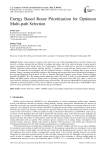
Energy Based Route Prioritization for Optimum Multi-path Selection
Статья научная
Energy–aware routing in wireless ad hoc networks is one of the demanding fields of research. Nodes of the network are battery operated that are difficult to recharge and replace, that's why while developing a routing protocol energy consumption metric should always be at high priority. Nodes of mobile ad hoc networks are distributed in different directions forming arbitrary topology instantly. To propose an energy-efficient routing protocol for such a dynamic, self-organized, self-configured, and self-controlled network is certainly a challenge and an open research problem. Energy constraints and mobility leading to link breakage are the motivating factors behind the development of the proposed Optimized Priority-based Ad Hoc on Demand Multi-path Distance Vector Energy Efficient Routing Protocol (OPAOMDV-EE). The routing protocol added three fields (CE, MAX_E, MIN_E) to the traditional AOMDV RREQ and RREP packets, which are further used for calculating total priority field value. This value is used by the source node for selecting an optimal prioritized energy-efficient route. The proposed OPAOMDV-EE protocol has been simulated on Network Simulator-2 (NS-2) for two different scenarios that prove the effectiveness of OPAOMDV-EE in terms of various performance metrics with reduced energy consumption.
Бесплатно

Energy Conscious based Multipath Routing Algorithm in WSN
Статья научная
Wireless Sensor Network (WSN) is a collection of sensory nodes forming a provisional network without the assistance of any recognized infrastructure. Due to the minimal range of each node's transmissions, it may be essential for one sensory node to request for the aid of other sensory node in transferring a packet between the source and sink. The important issue while designing WSN is the routing protocol that makes the best use of the severely minimal resource, especially the energy consumption. We propose a Energy Conscious multipath Routing Algorithm designed to improve the latency, resiliency and efficiency through discovering multiple routes between the source and sink. A Sink Originated Route Discovery (SORD) process provides the locality information of the source to the sink. One dominant and multiple alternate routes are generated at the end of the route discovering process. Apart from the dominant route, all the other nodes are put to sleep mode in order to conserve energy and create a concussion free route. Data is transmitted between the source and sink through the dominant route and if there is a disturbance in the existing route, the next preferred alternate route is used. If the route doesn't exist between the source and sink, the process starts from the beginning. Further, we analyze how the proposed protocol overcomes the drawback of the existing protocols. This system is implemented by using NS-2.34. By altering route update guidelines of existing on-demand routing schemes the Performance gains in the order of 10-15 % could be achieved. The simulation results show that the proposed protocol has less control packet overhead, less average energy consumption and the algorithm is faster.
Бесплатно
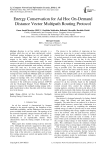
Energy Conservation for Ad Hoc On-Demand Distance Vector Multipath Routing Protocol
Статья научная
Routing in ad hoc mobile networks is a problem which has not yet been satisfactorily solved. Traditional routing techniques are not well adapted to new networks. Indeed, their lack of reactivity with respect to the traffic and network changes means traditional routing techniques cannot easily be used except at the price of over-dimensioning of the network resources (network bandwidth, node memory utilization, node CPU load, etc.). In recent years the research community has been interested in the improvement of ad hoc routing, and among the solutions suggested multipath routing has been considered. Multiple paths are exploited in order to ensure reliability and a quick reaction to changes in topology with a low overhead generated by the control messages. In this article we present an extension of the well-known routing protocol AODVM (Ad hoc On-demand Distance Vector Multipath). We propose to improve the multipath routing strategy with a path classification to allow the paths with the best energy level to be chosen.
Бесплатно

Статья научная
The reduction of energy consumption in elastic optical networks is of major interest to the research community. As a result, several methods for solving this problem in combination with existing classical problems have been proposed. Elastic optical networks are subject to disturbance phenomena that degrade their quality and performance. To optimize resources, operators must recalculate new routes and plan the displacement of established connections towards these new routes to cope with these phenomena, it’s the reconfiguration. The problem addressed in this article is to reconfigure a set of unicast protected connections without interruption to a new routing calculated during the process. Knowing that the use of backup paths solves the interruption problem, but has an impact on the overall energy consumption, the goal is to find a good compromise between the two sub-problems when switching from old routes to new ones. To the best of our knowledge, there is no work on reconfiguration that uses energy-aware backup paths. In this work, we proposed an energy-aware EERA_EON rerouting algorithm using the backup paths. Simulations have shown the performance of this approach in terms of energy consumption compared to the work of our predecessors. Subsequently, we proposed a classical BRA_EON rerouting algorithm in elastic optical networks. Simulation results show that we perform BRA_EON in terms of the number of steps.
Бесплатно

Energy Efficient Clustering Protocol for Sensor Network
Статья научная
Energy efficiency is a very crucial issue for battery operated Wireless Sensor Networks (WSNs). Routing plays a major in energy dissipation and it is shown in the literature that Cluster based approach is the most energy effective in any network in comparison to direct or multi hop based approach. Therefore, optimized Clustering became a key point to achieve energy efficiency in Wireless Sensor networks. In this paper, we have designed and implemented a novel protocol in MATLAB in which Cluster Heads are chosen on the basis of energy threshold, minimum average distance from surrounding nodes and farthest distance among Cluster Heads to provide optimal coverage. This paper also compare results of randomly selected CHs and farthest CHs and results demonstrates that farthest chosen CHs provide much better results than randomly selected CHs. To further evaluate performance of our protocol, results of our protocol are compared with LEACH and proposed protocol dominates LEACH in terms of minimizing transmission distance, energy dissipation and hence increasing network lifetime. Apart from this, proposed protocol is based on Poisson distribution because simulation results clearly states that Poisson distribution is very well suited for WSN in comparison to Uniform and Random distribution.
Бесплатно
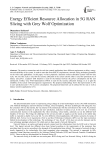
Energy Efficient Resource Allocation in 5G RAN Slicing with Grey Wolf Optimization
Статья научная
The massive connections and the real time control applications have different requirement on delay, energy, rate and reliability of the system. In order to meet the diversified 5G requirements, network slicing technique guarantees on the wide scale applications. In this paper, we have proposed a dynamic resource allocation system with two time scale. The one time scale is used for the resource allocation in the system and the other is used for optimized use of latency and power. Lyapunov drift function is used for the balance between the power consumption and the user satisfaction. Further, Grey Wolf Optimization (GWO) is used for the resource allocation strategy so as to gain the reliability of the system with heterogeneous requirements. The proposed methodology shows the improvement of 27% in user satisfaction and 17.5% in power consumption. The proposed framework can be utilized for the rate as well as latency sensitive applications in 5G.
Бесплатно
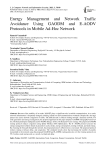
Статья научная
Because of the mobility of its nodes, MANET plays a significant role in mobile communication. As a result, network infrastructure is frequently changed, resulting in data loss and communication overheads. Despite this, the large packet size causes network congestion or traffic. The difficult task is efficient routing through a dynamic network. For node generation and energy management, the proposed approach in this paper employs GAODM (Geography-based Ad-hoc On Demand disjoint multipath) and E-AODM (Energy Ad-hoc On Demand Vector routing). The proposed GAODM routing protocol reduces congestion using Spider Monkey (SM) Optimization. The E- AODM protocol assesses the energy management solution based on parameters such as delay, energy consumption, routing overhead, and node energy. By choosing the best path through the network, the proposed protocol's effectiveness is increased. The proposed protocol reduces routing overload, delay, and congestion. The simulated results show that increasing the number of packets transmitted in the network using the proposed GAODM and E-AODM routing protocols over the existing protocols on NS 2 reduces node energy and, as a result, overload and delay.
Бесплатно
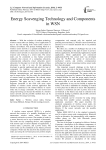
Energy Scavenging Technology and Components in WSN
Статья научная
With the evolution of modern technology wireless sensor nodes are finding a lot of applications in day to day life starting from smart home system to military surveillance. The primary building block of a wireless sensor network is a spatially distributed set of autonomous sensor nodes or motes. In order to design a wireless sensor network it is necessary to understand the structure and working of a sensor node. The sensor nodes can be considered as tiny battery powered computers that consists of a computing subsystem, communication subsystem, sensor subsystem, power subsystem. In this paper we review the features of these subsystems so that it is easy for the application developer to quickly understand and select the type of component for building customized sensor node platform. In this paper we have studied the features of different microprocessors and transceivers properties used in sensor nodes. We also study the classifications of sensors based on applications, the relevant sensor parameters, and different storage devices with their properties. This paper can be a ready reference to beginners interested in this field. One more major problem of wireless sensor network application that should be addressed is the limited lifetime of sensor nodes due to energy constraints. We also review how energy harvesting can increase the lifetime of a wireless sensor network and the possible methods that can be implemented for energy harvesting.
Бесплатно

Energy consumption in mobile phones
Статья научная
As the mobile devices are widely used in this world. With the increasing number of users, the numbers of customized applications are also introduced for these users according to their own requirements but on the other hand, there is a dire need of a system which must be energy conserved, estimated and maintained. A survey of energy consumption in mobile phones is presented in this paper with the factors at which the consumption of the energy depends on i.e. Energy consumed by OS, by hardware, by applications, by the user to interact with the applications, by wireless, by the sensor network. The energy management models and frameworks are also discussed in this paper.
Бесплатно
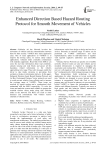
Enhanced Direction Based Hazard Routing Protocol for Smooth Movement of Vehicles
Статья научная
Vehicular Ad hoc Network involves the movement of vehicles and the communication between them for their security. VANETs have many application areas. One of main applications of VANETs is to improve the driving safety. In various safety related applications, vehicular nodes constantly communicate with roadside equipments. Road Side Units (RSUs) can sense the real time information about road conditions, animals straying and road blocks and passes all this hazardous related information to the vehicles approaching in its range. These alert messages enable the driver to take timely decisions in preventing from accidents or delays in information delivery. In this paper, Enhanced Direction based Hazard Routing Protocol and Ad Hoc On-demand Distance Vector protocols are used to avoid prevent vehicles from collision and to increase the coverage range of VANETs. These issues are resolved by bypass routing and a synchronized clock maintained with the RSUs respectively. To solve the issues and make the system more reliable we propose the roadside wireless sensor nodes along with vehicular nodes in the network. The RSUs are fixed at some distances and communicate with wireless sensors attached at vehicular nodes.
Бесплатно
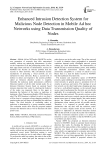
Статья научная
Mobile Ad hoc NETworks (MANETs) are the new generation of networks that offer unrestricted mobility without any underlying infrastructure. It relies on the cooperation of all the participating nodes. Due to their open nature and lack of infrastructure, security for MANETS has become an intricate problem than the security in other networks. The conventional security mechanisms of protecting a wired network are not sufficient for these networks. Hence a second level of defense to detect and respond to the security problem called an Intrusion detection system is required. Generally the malicious nodes demonstrate a different behavioral pattern of all the other normal nodes. So an Intrusion Detection System based on anomaly based intrusion detection that works by checking the behavior of the nodes was proposed. Here, in this paper to determine the behavior of the nodes as malicious or legitimate a Data Transmission Quality (DTQ) function is used. The DTQ function is defined in such a way that it will be close to a constant or keep changing smoothly for genuine nodes and will keep on diminishing for malicious nodes.. The final decision of confirming nodes as malicious is determined by a group consensus method. The evaluation results show that the proposed method increases the detection rate as well as decreases the false positive rate.
Бесплатно
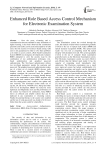
Enhanced Role Based Access Control Mechanism for Electronic Examination System
Статья научная
Over the years, e-learning and e-examination has become standard in many institutions of higher learning. It has been observed that examination questions and results can be easily intercepted by invalid users, thus the security of resources shared among valid users is not guaranteed. In order to solve these problems as it relates to access control, a Role based Examination System (RBES) was designed, developed and evaluated. RBES attempted to solve the security issue by the combination of two authentication techniques: text-based authentication and graphical password authentication. The Text-based authentication utilizes two text-based parameters namely the username and password. The graphical password authentication makes use of a finite set of controls (RBES chooses radio buttons) which are identified by numbers. These numbers constitute the password used for graphical authentication. To improve on resource sharing among users in the examination system, RBES proposes role management (role creation, role update, role removal) and user management (user creation, user update and user removal). The developed system made use of asp.net, C#, IIS server, WAMP server, Mysql and other tools for its development. RBES was tested by some legitimate and illegitimate users and the performance of the system was found to be satisfactory, hence RBES shows an efficient and reliable scheme that can be deployed in any examination or e-learning system. Finally the potential threats to the system were modeled and the use of weak passwords was found to be the most likely threat the system could be vulnerable to.
Бесплатно

